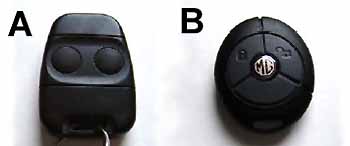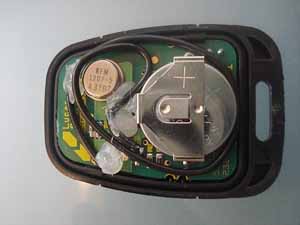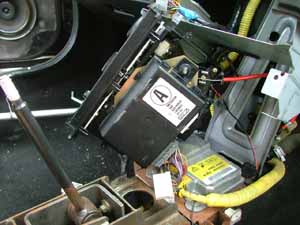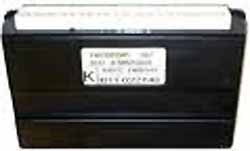|
|
The alarm/immobiliser system
|
 The
MGF and MGTF are equipped as standard with a passive-arming immobiliser system
as part of the vehicle’s security suite that also includes dead-locking doors,
steering wheel lock and security coded in-car entertainment headunits. From
launch, the immobiliser function was performed by the Lucas 5AS system, a system
that benefited from continual development throughout the period of manufacture.
The Lucas 5AS gained full Thatcham Category 2 certification in July, 1997 [1],
and more latterly, in late 1998, the 5AS gained a further refinement: passive
disarming. A small magnetic coil in the ignition barrel excites a coil in the
key fob, causing the transponder in the fob to automatically send a signal to
the Lucas electronic control unit (ECU) to disarm the immobiliser – a very
useful refinement in the system that significantly adds to owner convenience.
The
MGF and MGTF are equipped as standard with a passive-arming immobiliser system
as part of the vehicle’s security suite that also includes dead-locking doors,
steering wheel lock and security coded in-car entertainment headunits. From
launch, the immobiliser function was performed by the Lucas 5AS system, a system
that benefited from continual development throughout the period of manufacture.
The Lucas 5AS gained full Thatcham Category 2 certification in July, 1997 [1],
and more latterly, in late 1998, the 5AS gained a further refinement: passive
disarming. A small magnetic coil in the ignition barrel excites a coil in the
key fob, causing the transponder in the fob to automatically send a signal to
the Lucas electronic control unit (ECU) to disarm the immobiliser – a very
useful refinement in the system that significantly adds to owner convenience.
The Lucas system continued for the duration of MGF manufacture and initially continued through to the introduction of the newer TF launched in 2002. However by 2003, the immobilizer was changed as part of a wide-ranging wiring system upgrade, being supplanted by the Pektron Security Control Unit (SCU). The Pektron SCU took over the functions of not only the immobiliser, but also of the Multifunction Unit (MFU), controlling ancillary functions such as wipers, fog lamps and horns – thus integrating all complex electronic logic functions into a single ECU.
|
|
The two systems are readily identifiable from the type of un-locking key fob employed. The earlier Lucas system used a square key fob with two buttons (initially the 3TXA hand unit, but later supplanted by the superior 3TXB and more latterly by the 17TN fob). The Pektron SCU system employed a circular key fob, complete with an attractive central MG logo and two buttons (later versions used a third button as a boot lid ‘popper’).
Each system has their pros and cons.
This is by far the most numerous system, being employed in all MGFs manufactured, and a useful number of early TFs as well. The Lucas immobiliser has proven itself as a reliable system – but with some limitations.
Short signal range
The most frequent complaint with respect to these key fobs are their limited signal range. There are at least three solutions for this problem:
Solution #1
|
|
The commonest solution to this problem is to
locate the yellow aerial cable that is attached to the 5AS ECU unit, found
under the heater control box in the centre dashboard. This is readily accessed
by removing the passenger foot well panel (it holds the foot well lamp, and is
retained by just two screws). The yellow cable is typically taped up to the
main wiring loom. Detach, straighten and re-tape safely, and you should find a
useful improvement in range (i.e. you don’t need to hold the plipper right up
to the window to operate!)
Solution #2
|
|
The next solution is to adopt what I would now
call the "Lucas position" – which is to hold the plipper up against
the chin and then press the button (I do this without thinking now!). It then
uses your skeleton as an extension to the emitter aerial, providing a useful
boost in signal range. It is perhaps a little difficult not to look daft while
doing it though - sorry about that.
Solution #3
|
|
A rather more involved approach is to extend the aerial length of the emitter inside the key fob casing itself. There’s been one successful report of this having been done, using a 20cm wire soldered to the PCB-mounted aerial with a very useful extension in range. Whether you feel that confident with a soldering iron is something only you can decide!
Radiofrequency interference
Early, pre-1996 Lucas 5AS units used an earlier design radio-frequency receiver. Later re-designed, these early units can be very susceptible to local radio-frequency (RF) interference. This can prove to be a real nuisance – but rectification could prove to be either inconvenient or expensive (or both). Two options are:
- Replace the existing Lucas 5AS ECU with a later version, get the engine control unit coded to the new Lucas unit, and your existing fobs coded to that. Or –
- Send away your existing 5AS unit to a specialist for replacement of the RF receiver.
Finally, the fobs – and particularly the rubber buttons are prone to wear. Fortunately the micro switches seem to survive well, and all that is required is a replacement case – which is supplied as part of a repair kit, part number YWX101010.
Coding in a new/replacement key fob (Lucas 5AS system)
Originally, all MGFs were supplied new with two keys and two key fobs. Over the passage of time, the second key and fob may have become lost. This is not a disaster. New or second hand key fobs can be coded into the security system relatively easily provided that you can get your car to a garage that possess the Rover Testbook diagnostic equipment. [2]
|
|
Interestingly, any of the Lucas key fobs can be used – be that from Land Rover or other Rover models, as 3TXA, 3TXB even 3TXC and 17TN units (they all look outwardly similar). It has even been suggested that the Lucas 3TXB transponder, as used with the 1996 Nissan Micra (built in the UK in Sunderland), might also be used [3] – but I don’t know of anyone who has gone and proven this! Please note though that earlier key fobs will not function with the later auto-disarm function, lacking the necessary receiver coil – so for later vehicles, look for 17TN fobs out of preference. Also be aware that early Lucas key fob PCBs can be re-packaged into later Lucas cases – so beware. But the good news for early MGF owners is that none of this matters not one jot! Any fob will do the job!
One word of warning: not all Lucas key fobs were created equal. This warning is pertinent to those components that have been re-imported from elsewhere in the world. In particular, the radio frequency ranges used in markets such as Japan are different to those certified for use in the UK and the rest of the European Union. For the record, the EU uses 433MHz, and Japan and some other export markets, 315MHz.
To identify with frequency of your Lucas 5AS receiver requires you to look at the ECU’s outer casing. On it is a white label, and on the right of this, there is a letter within a circle. If this letter shows an A/H/L or R, then you are looking at a 433MHz receiver. If the letters are any one of M/K/S or T, then the frequency is 315MHz.
|
|
To identify the frequency of the emitter transponder in the key fob is a little trickier, as there is no outward identification on the casing (labelled 3TXA, 3TXB, 3TXC or 17TN in all markets). To do this, you need to look at the transponder itself on the printed circuit board (PCB) – a 1239 resonator signifies a 315MHz transponder, and 1207 a 433MHz unit. [3]
|
Programming for a new key fob: Programming procedure for the Lucas 5AS unit is straightforward. On testbook, the ECU is put into a programming mode. Once in this mode, the 5AS will accept any code sent to it 8 times in quick succession – hence the need for each of the key fobs to be present at the time of programming, and for the fob to be in full working order. |
When reprogramming the Lucas ECU, it is important to know that all available key fobs (up to eight can be programmed, although quite why you’d need this many is a bit of a mystery) need to be present and in functioning order (replace the battery if needed!) at the time of re-programming; all old/redundant key fob codes are erased at this time.
For the MG enthusiast (or kit car/specials builder) the Lucas system has a
significant benefit over the later Pektron unit. When it comes to programming
the Lucas unit, you do not require either the Emergency Key Access (EKA) code or
a functioning key fob. Therefore, when it comes to re-commissioning an early
MGF, all you need is access to Testbook, a new key fob with a fresh battery, and
you are on your way.
The Pektron SCU
|
|
The later Pektron security control units (SCUs) have not, unfortunately, enjoyed the same excellent reputation for reliability as the earlier Lucas units. The Pektron SCU takes on many other body control functions (it is also known as the body control unit (BCU)) and in effect, replaced both the Lucas 5AS immobiliser ECU and the Multi-function Unit (MFU) of the earlier cars. These units have provided a number of reliability issues – with software and firmware glitches as well as hardware faults with burn out of key components (which may manifest with various issues such as non-operation of fog lamps or horns – or indeed complete unit and therefore system failure [4]).
More problematic for the MG owner on a budget (or in the days when these units are no longer available), it appears to be impossible to re-programme a used Pektron SCU if you do not have a matched and working key fob or failing that, the EKA to go with it. The issue here is that the SCU locks out Testbook when the immobiliser is active. Therefore, when a unit fails, it becomes nearly mandatory to purchase a new one unless a used matched fob/EKA and SCU can be found…
The good news is that the Pektron SCU provides some additional new features – on later TFs (particularly the SAIC era cars), there is a remote boot release option, and also passive alarm activation. Better still, the signal range with these units are usefully better than when compared to the Lucas equivalent! So you trade features and alarm range for reliability. I suspect I know what most people would prefer in the long run…
Coding in a new/replacement key fob (Pektron SCU system)
The Good news/Bad news story continues here too. Like the Lucas system described above, it is perfectly feasible to code in new key fobs/plippers into the Pektron system. The bad news is that there are a few additional security hurdles to cross – and thanks to shaky software/firmware, attempts to programme the Pektron has reportedly lead to system lock-ups…
Extra security features
To code a new key fob with the Pektron SCU, you will need a fully working key fob (already coded to the system) or the EKA. This means that if you buy a car without the above, you’re faced with a bill to replace not only the missing or faulty key fobs, but also to buy a new Pektron SCU. Ouch.
Fortunately, you can code in a second hand key fob for use with the Pektron SCU – HOWEVER you will also need the 22-digit bar code. Without it, the key fob is essentially useless and therefore scrap. [2]
As with the Lucas 5AS, when reprogramming the Pektron SCU to use additional key fobs, you need all your key fobs present and in full working order; any key fobs not present at the time of re-programming will be deleted from file. Interestingly, it appears that you don’t need the 22-digit bar code for the existing key fobs, just for any that the Pektron SCU hasn’t ‘seen’ before.
By this extension, if you are fitting a new Pektron SCU, ensure that you have the 22-digit bar codes for your existing fobs, as the ‘new’ SCU won’t have ‘seen’ your old key fobs before. You may find this original 22-digit code label stuck inside your car’s service booklet.
If you don’t have this code, these key fobs are, I am afraid, scrap.
Both the Lucas 5AS and Pektron SCU offer an emergency manual override of the immobiliser in the event of a flat battery in the key fob. This is the emergency key access (EKA) code. You should have a copy of this with the owner’s handbook and documentation. If you don’t have it, don’t panic. This can be retrieved by attaching the car to Testbook, and the EKA can be retrieved. Equally there are a number of companies on the internet that can provide you with the EKA information based on the Vehicle Identification Number (VIN) for a charge.
How does the EKA work?
Entering the EKA is very straightforward. You need the ignition key (hopefully this is the same as the door key!). Insert key into the driver’s door lock. Now, taking the the EKA to be "2468":
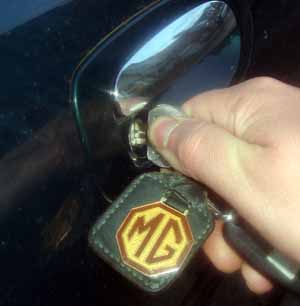 |
The immobiliser should now be deactivated, the alarm indicator light will stop flashing and the engine can be started.
If the code has been entered incorrectly, a warning beep will sound when the key is turned to the final unlocked position.
If this occurs, open and close the door (this will cancel the error), and enter the code again.
However, there was a problem with early MGFs, as the cars were dispatched from the factory with an incorrect EKA (a software error on the code generating computer on the production line). This incorrect number may still be with your car.
The standard correction for this factory labelling error is to add "1" to the 2nd and 4th digit. Thus, taking our example EKA above of "2468", this becomes "2569".
 Note that there is a 10 minute lockout after 3 failed EKA entry attempts – so
there is plenty of time to find a branch to flog your car with if you find
yourself in this situation…
Note that there is a 10 minute lockout after 3 failed EKA entry attempts – so
there is plenty of time to find a branch to flog your car with if you find
yourself in this situation…
-
Thatcham Security ratings on MG Rover vehicles: http://www.thatchamsecurity.co.uk/car/category_2/original_equipment/rover.htm
-
Autodiagnosis - Rover Lucas 5AS and Pektron SCU key fob programming and EKAs: http://www.autodiagnos.com/fileadmin/assets/en/downloads/pdf/technical_bulletins/rover/rover_plip.pdf
-
Dieter's excellent summary on the technical aspects of the MGF/TF Immobiliser and Key fobs: http://www.mgfcar.de/alarm_blipper/eblipper.htm
-
The MG Rover forums - on of the many threads regarding the Pektron SCU: http://forums.mg-rover.org/showthread.php?p=2695156
